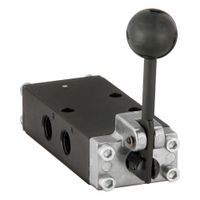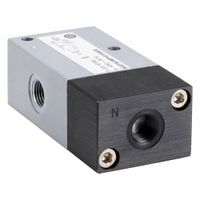Call +(254) 703 030 000 / 751 483 999 / 721 704 777
- Home
- Pneumatics
- Pneumatic Valves
- Inline Air Control Valves
.....Read More
Frequently Asked Questions
What are inline air control valves used for?
Inline air control valves are used to regulate, direct, or control the flow of air within a pneumatic system. They are essential components in various industrial and commercial applications, providing precise control over air pressure, flow rate, and direction. These valves help optimize the performance and efficiency of pneumatic systems by ensuring that the right amount of air is delivered to the right place at the right time.
Key functions of inline air control valves include:
1. **Flow Regulation**: They adjust the volume of air passing through a system, which is crucial for maintaining desired operational parameters and ensuring consistent performance.
2. **Pressure Control**: By modulating the air pressure, these valves help protect equipment from damage due to overpressure and ensure that pneumatic tools and machinery operate within their specified pressure ranges.
3. **Direction Control**: Inline air control valves can change the direction of airflow, which is vital for applications requiring the reversal of motion, such as in pneumatic cylinders.
4. **On/Off Control**: They can start or stop the flow of air, functioning as a switch to control the operation of pneumatic devices.
5. **Speed Control**: By controlling the rate of airflow, these valves can adjust the speed of pneumatic actuators, allowing for smooth and precise movements.
Inline air control valves are used in various industries, including manufacturing, automotive, aerospace, and HVAC systems. They are critical in applications such as automation systems, air compressors, and any process requiring controlled air delivery. Their ability to enhance system efficiency, reliability, and safety makes them indispensable in modern pneumatic systems.
How do solenoid-operated inline air control valves work?
Solenoid-operated inline air control valves function by using an electromagnetic solenoid to control the flow of air through a valve. These valves are integral in pneumatic systems, where they regulate the direction, pressure, and flow rate of compressed air.
The core component of these valves is the solenoid, which consists of a coil of wire that generates a magnetic field when an electric current passes through it. This magnetic field moves a plunger or armature within the solenoid. The movement of the plunger is what opens or closes the valve.
When the solenoid is energized, the magnetic field pulls the plunger into the coil, which either opens or closes the valve depending on its design. In a normally closed valve, the plunger blocks the air passage when de-energized, preventing air flow. Energizing the solenoid retracts the plunger, allowing air to pass through. Conversely, in a normally open valve, the plunger allows air flow when de-energized and blocks it when energized.
These valves can be configured in various ways, such as two-way, three-way, or four-way, depending on the number of ports and flow paths required. Two-way valves control the flow in a single line, while three-way and four-way valves can direct air between multiple lines, making them suitable for more complex pneumatic circuits.
Solenoid-operated inline air control valves are valued for their rapid response times, reliability, and ease of integration into automated systems. They are used in applications ranging from industrial automation to HVAC systems, where precise control of air flow is essential.
What is the difference between manually-activated and solenoid-operated inline air control valves?
Manually-activated and solenoid-operated inline air control valves differ primarily in their mode of operation and application.
Manually-activated inline air control valves require human intervention to operate. They are typically equipped with levers, knobs, or handles that an operator must physically manipulate to open, close, or adjust the flow of air. These valves are simple, cost-effective, and do not require an external power source, making them suitable for applications where automation is not necessary or where power sources are unavailable. They are often used in systems where adjustments are infrequent or where precise control is not critical.
Solenoid-operated inline air control valves, on the other hand, are electrically controlled. They use a solenoid, which is an electromagnetic coil, to actuate the valve. When an electrical current passes through the solenoid, it generates a magnetic field that moves a plunger or armature, opening or closing the valve. These valves are ideal for automated systems, allowing for remote control and integration into complex processes. They offer precise control, quick response times, and can be easily integrated with sensors and controllers for automated operations. Solenoid valves are commonly used in applications requiring frequent or rapid changes in air flow, such as in manufacturing, automotive, and HVAC systems.
In summary, the key difference lies in the operation: manually-activated valves require physical manipulation, while solenoid-operated valves use electrical signals for actuation, offering greater automation and control capabilities.
How do pilot-operated inline air control valves function?
Pilot-operated inline air control valves function by using a smaller pilot valve to control a larger main valve, allowing for efficient management of air flow in pneumatic systems. The process begins with the pilot valve, which is typically solenoid-operated. When the solenoid is energized, it opens the pilot valve, allowing a small amount of air to flow into a chamber or control line connected to the main valve.
This pilot air pressure acts on a diaphragm or piston within the main valve, creating a force that overcomes the spring or other closing force holding the main valve shut. As a result, the main valve opens, allowing a larger volume of air to pass through the system. This setup enables the control of high-pressure or high-flow air systems with minimal electrical input, as the pilot valve requires significantly less power to operate than the main valve.
The design of pilot-operated valves allows for precise control of air flow, as the pilot valve can be modulated to adjust the pressure applied to the main valve, thus controlling its degree of opening. This modulation can be achieved through varying the electrical input to the solenoid or by using a proportional pilot valve.
Pilot-operated inline air control valves are advantageous in applications requiring rapid response and high flow rates, as they combine the benefits of direct solenoid control with the capacity to handle larger volumes of air. They are commonly used in industrial automation, process control, and other pneumatic systems where efficient and reliable air flow management is essential.
What are the advantages of using inline air control valves in pneumatic systems?
Inline air control valves offer several advantages in pneumatic systems:
1. **Compact Design**: Inline valves are designed to be compact, allowing them to be easily integrated into existing systems without requiring significant space. This is particularly beneficial in applications where space is limited.
2. **Ease of Installation**: These valves can be installed directly into the air line, simplifying the installation process. This reduces the need for additional fittings and connections, which can save time and reduce potential leak points.
3. **Improved System Efficiency**: By providing precise control over airflow, inline valves help optimize the performance of pneumatic systems. This can lead to improved efficiency and reduced energy consumption, as the system can be fine-tuned to operate only as needed.
4. **Enhanced Control**: Inline air control valves offer precise control over the speed and movement of pneumatic actuators. This precision is crucial in applications requiring accurate positioning and timing.
5. **Versatility**: These valves are available in various types and sizes, making them suitable for a wide range of applications. They can be used in different industries, including manufacturing, automotive, and packaging.
6. **Reduced Maintenance**: With fewer components and connections, inline valves can lead to lower maintenance requirements. This can result in reduced downtime and lower operational costs over the lifespan of the system.
7. **Cost-Effectiveness**: The simplicity and efficiency of inline valves can lead to cost savings in both the short and long term. Initial installation costs are often lower, and the improved efficiency can reduce operational expenses.
8. **Reliability**: Inline air control valves are designed to withstand harsh operating conditions, providing reliable performance over time. This durability ensures consistent operation and reduces the likelihood of system failures.
How do you install an inline air control valve?
1. **Select the Valve**: Choose an inline air control valve suitable for your system's pressure and flow requirements.
2. **Gather Tools and Materials**: You will need the valve, appropriate fittings, pipe cutter, thread sealant or Teflon tape, and wrenches.
3. **Shut Off Air Supply**: Turn off the air supply to the section of the system where the valve will be installed. Release any residual pressure by opening a downstream valve.
4. **Mark Installation Point**: Identify and mark the section of the pipe where the valve will be installed. Ensure it is accessible for future maintenance.
5. **Cut the Pipe**: Use a pipe cutter to cut the pipe at the marked location. Ensure the cut is clean and straight.
6. **Prepare Pipe Ends**: Deburr and clean the cut ends of the pipe to ensure a proper seal.
7. **Attach Fittings**: If necessary, attach appropriate fittings to the pipe ends. Use thread sealant or Teflon tape on threaded connections to prevent leaks.
8. **Install the Valve**: Position the valve between the pipe ends or fittings. Ensure the flow direction marked on the valve aligns with the system's flow direction.
9. **Secure Connections**: Tighten the connections using wrenches. Avoid over-tightening to prevent damage to the valve or fittings.
10. **Check Alignment**: Ensure the valve is properly aligned and securely fastened.
11. **Restore Air Supply**: Slowly turn on the air supply to the system.
12. **Test for Leaks**: Check for leaks by applying a soapy water solution to the connections. Look for bubbles indicating a leak.
13. **Adjust Valve**: If the valve is adjustable, set it to the desired flow rate or pressure.
14. **Monitor Performance**: Observe the system to ensure the valve is functioning correctly and maintaining the desired control.
What maintenance is required for inline air control valves?
Maintenance for inline air control valves involves several key steps to ensure optimal performance and longevity:
1. **Regular Inspection**: Conduct routine visual inspections to check for signs of wear, corrosion, or damage. Ensure that all connections are secure and that there are no leaks.
2. **Cleaning**: Periodically clean the valve components to remove dust, debris, and any buildup that could affect performance. Use appropriate cleaning agents that do not damage the valve materials.
3. **Lubrication**: Apply suitable lubricants to moving parts to reduce friction and wear. Ensure that the lubricant is compatible with the valve materials and the type of air being controlled.
4. **Seal and Gasket Check**: Inspect seals and gaskets for wear or damage. Replace them if necessary to prevent leaks and ensure proper sealing.
5. **Calibration**: Regularly calibrate the valve to ensure it operates within the desired parameters. This may involve adjusting the actuator or control settings.
6. **Testing**: Perform functional tests to verify that the valve opens and closes correctly and that it regulates air flow as intended. Check for any unusual noises or vibrations during operation.
7. **Replacement of Worn Parts**: Replace any worn or damaged parts promptly to prevent further damage and maintain efficiency.
8. **Documentation**: Keep detailed records of all maintenance activities, including inspections, cleaning, lubrication, and parts replacement. This helps in tracking the valve's performance and planning future maintenance.
9. **Training**: Ensure that maintenance personnel are properly trained in handling and servicing the specific type of inline air control valve in use.
10. **Follow Manufacturer Guidelines**: Adhere to the maintenance schedule and procedures recommended by the valve manufacturer to ensure compliance with warranty and safety standards.


